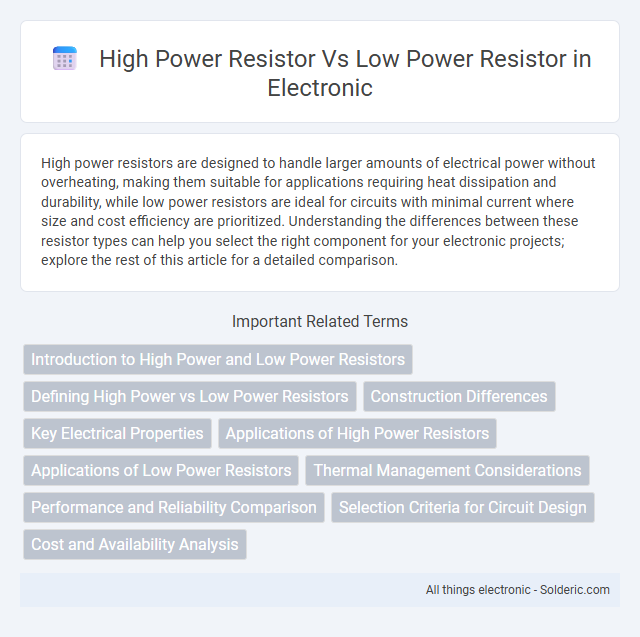High power resistors are designed to handle larger amounts of electrical power without overheating, making them suitable for applications requiring heat dissipation and durability, while low power resistors are ideal for circuits with minimal current where size and cost efficiency are prioritized. Understanding the differences between these resistor types can help you select the right component for your electronic projects; explore the rest of this article for a detailed comparison.
Comparison Table
| Feature | High Power Resistor | Low Power Resistor |
|---|---|---|
| Power Rating | > 1 Watt (Typically 5W, 10W, up to 100W+) | <= 1 Watt (Commonly 0.125W to 1W) |
| Heat Dissipation | High; requires heat sinks or cooling | Low; passive cooling sufficient |
| Size | Large physical size | Compact and small |
| Material | Wirewound, Metal oxide, Ceramic | Carbon film, Metal film, Thin film |
| Applications | Power supplies, Motor controls, Load testing | Signal processing, Circuit protection |
| Cost | Higher per unit cost | Lower cost |
| Tolerance | Generally +-5% or looser | Can be as tight as +-0.1% |
Introduction to High Power and Low Power Resistors
High power resistors are designed to dissipate large amounts of energy, commonly exceeding 1 watt, making them essential for applications involving high current and voltage such as power supplies, motor drives, and industrial equipment. Low power resistors typically handle less than 1 watt of power, used in signal processing, small electronic circuits, and precision measurement devices where heat dissipation is minimal. These resistors differ significantly in construction, material composition, and cooling requirements to accommodate their respective power ratings and thermal management.
Defining High Power vs Low Power Resistors
High power resistors are designed to dissipate significant amounts of heat, typically rated above 1 watt, and are used in applications requiring the management of high current or voltage loads. Low power resistors generally handle less than 1 watt and are suited for low current circuits with less thermal stress. The key difference lies in their power dissipation capacity, physical size, and thermal management to ensure reliability and performance in specific electronic designs.
Construction Differences
High power resistors are constructed with thicker resistive elements and enhanced heat dissipation materials like ceramic or metal oxide substrates to handle higher wattage without damage. Low power resistors typically use thinner wire or film elements on smaller, less robust bases, optimized for minimal heat generation and compact size. Your choice between these resistor types depends on the application's power rating and thermal management requirements.
Key Electrical Properties
High power resistors typically handle wattages above 1 watt and exhibit lower resistance values with higher current ratings, enabling effective dissipation of substantial heat without performance degradation. Low power resistors usually operate below 1 watt, featuring precise resistance tolerances and stability suited for signal and low-current applications. The key electrical properties to compare include power rating, resistance value, tolerance, and thermal coefficient, where high power resistors prioritize heat dissipation and durability, while low power resistors emphasize accuracy and noise minimization.
Applications of High Power Resistors
High power resistors are primarily used in applications requiring the dissipation of significant amounts of electrical energy, such as power supplies, motor drives, and load testing equipment. These resistors manage high currents and voltages in industrial machinery, ensuring safe operation by limiting current and protecting circuits from overloads. Their robust design makes them essential for applications involving power regulation, energy absorption, and heat management in electronics and electrical systems.
Applications of Low Power Resistors
Low power resistors are commonly used in signal processing, voltage division, and biasing applications where minimal heat dissipation is required. These resistors are ideal for electronic circuits such as amplifiers, sensors, and consumer electronics due to their compact size and precision. You can rely on low power resistors to ensure accurate current control without excessive power loss.
Thermal Management Considerations
High power resistors require advanced thermal management techniques such as heat sinks, thermal pads, or forced air cooling to dissipate significant heat generated during operation. Low power resistors typically rely on their physical size and natural convection to manage heat without additional cooling components. Proper thermal management in high power resistors ensures reliability, prevents thermal runaway, and extends component lifespan by maintaining safe operating temperatures.
Performance and Reliability Comparison
High power resistors excel in handling larger currents and dissipating heat more efficiently, ensuring stable performance under demanding electrical loads, whereas low power resistors are limited to lower current capacities and are more prone to thermal stress and failure. The enhanced thermal management in high power resistors contributes to greater reliability and longer operational lifespan, particularly in industrial and high-power applications. Low power resistors often face increased resistance drift and potential damage when subjected to excessive power, impacting circuit stability and overall device longevity.
Selection Criteria for Circuit Design
High power resistors are essential when circuits require handling high voltage or dissipating significant heat, ensuring reliability and safety in power electronics. Low power resistors suit precision applications with minimal energy dissipation, optimizing accuracy and efficiency in signal processing. Your selection criteria should consider power rating, thermal management, physical size, and tolerance to match the resistor to your circuit's electrical and environmental demands.
Cost and Availability Analysis
High power resistors typically cost more due to their ability to handle greater wattage and require specialized materials and larger packaging. Low power resistors are widely available and more economical, making them suitable for cost-sensitive projects or high-volume production. Your choice depends on the application's power requirements balanced against budget constraints and component accessibility.
High power resistor vs low power resistor Infographic

 solderic.com
solderic.com